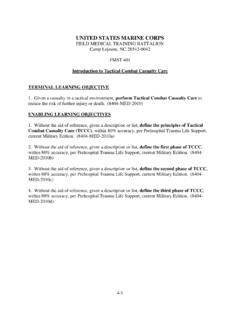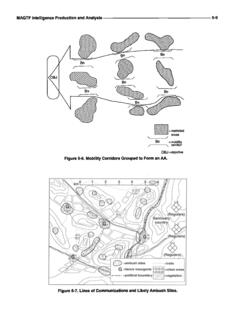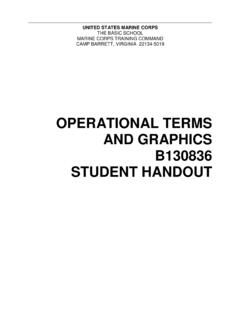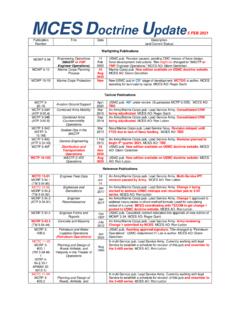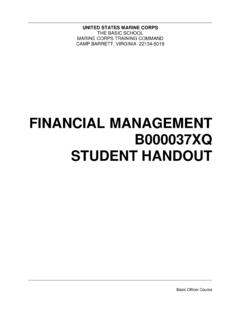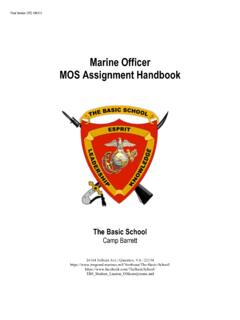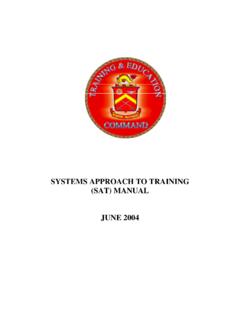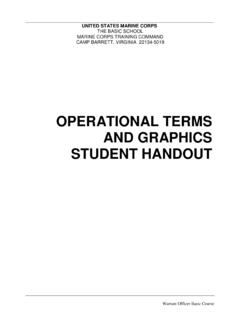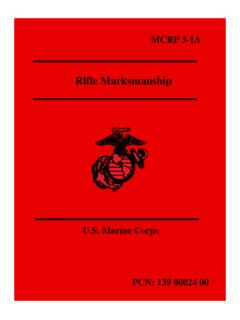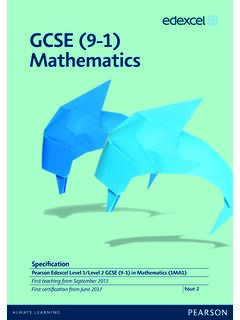Transcription of OPERATIONAL RISK MANAGEMENT B130786 STUDENT …
1 UNITED STATES MARINE CORPS THE BASIC SCHOOL MARINE CORPS TRAINING COMMAND CAMP BARRETT, VIRGINIA 22134-5019 OPERATIONAL RISK MANAGEMENT B130786 STUDENT HANDOUT Basic Off icer Course B130786 OPERATIONAL Risk MANAGEMENT 2 Basic Officer Course OPERATIONAL Risk MANAGEMENT (ORM) Introduction This purpose of this class is to provide basic instruction on the fundamentals of OPERATIONAL Risk MANAGEMENT (ORM) and to highlight the procedures and responsibilities that all Marines must take in both an OPERATIONAL and non- OPERATIONAL environment in order to identify hazards and eliminate or reduce the risks associated with them. Importance OPERATIONAL Risk MANAGEMENT is eve ry Marine s duty and responsibility, regardless of rank.
2 By properly applying the fundamentals of ORM, Marines have the ability to correct ly identify hazards and eliminate unnece ssary risk or reduce necessary risk to an acceptable leve l. In This lesson This lesson co vers the following topics: Topic Page Risk MANAGEMENT Fundamentals 4 OPERATIONAL Risk MANAGEMENT (ORM) Principles 5 ORM 5 Step Process/ BAMCIS/METT-T 6 ORM Levels 13 Summary/CMC Guidance 13 References 14 Glossary of Terms and Acronyms 14 Notes 15 B130786 OPERATIONAL Risk MANAGEMENT 3 Basic Officer Course OPERATIONAL Risk MANAGEMENT (ORM) (Continued) Learning Objectives Terminal Learning Objectives TBS-TRNG-2008 Given an OPERATIONAL Risk Assessment Worksheet (ORAW), training materials, training plan, and with the aid of references, conduct OPERATIONAL Risk Assessment to mitigate risks associated with each training event by identifying and incorporating control measures through the OPERATIONAL Risk Assessment Worksheet (ORAW) in accordance with the references.
3 Enabling Learning Objectives TBS-TRNG-2008a Given an OPERATIONAL Risk Assessment Worksheet (ORAW), training materials, training plan, and with the aid of references, identify hazards to mitigate risks associated with each training event by identifying and incorporating control measures through the OPERATIONAL Risk Assessment Worksheet (ORAW). TBS-TRNG-2008b Given an OPERATIONAL Risk Assessment Worksheet (ORAW), training materials, training plan, and with the aid of references, assess hazards to mitigate risks associated with each training event by identifying and incorporating control measures through the OPERATIONAL Risk Assessment Worksheet (ORAW). TBS-TRNG-2008c Given an OPERATIONAL Risk Assessment Worksheet (ORAW), training materials, training plan, and with the aid of references, make risk decisions to mitigate risks associated with each training event by identifying and incorporating control measures through the OPERATIONAL Risk Assessment Worksheet (ORAW).
4 TBS-TRNG-2008d Given an OPERATIONAL Risk Assessment Worksheet (ORAW), training materials, training plan, and with event by identifying and incorporating control measures through the OPERATIONAL Risk Assessment Worksheet (ORAW). TBS-TRNG-2008f Given an OPERATIONAL Risk Assessment Worksheet (ORAW), training materials, training plan, and with the aid of references, describe how to assess effectiveness of control measures to ensure continued safety throughout each training event. TBS-TRNG-2008g Without the aid of reference, describe the purpose of OPERATIONAL risk assessment, without error. TBS-TRNG-2008h Given an evaluation, describe safety as part of professionalism without error. B130786 OPERATIONAL Risk MANAGEMENT 4 Basic Officer Course Risk MANAGEMENT Fundamentals Risk MANAGEMENT is the proce ss of identifying, assess ing, and controlling risks arising from OPERATIONAL factors and maki ng deci sions that balance risk co sts with mission benefits.
5 Leaders and Marines at all levels use risk MANAGEMENT . It applies to all missions and environments across the wide range of Marine Corps operations. Risk MANAGEMENT is fundamental in developing confident and co mpetent leaders and units. Proficiency in applying risk MANAGEMENT is critica l to conserving co mbat power and reso urce s. Commanders must firmly ground cu rrent and future leaders in the cr itica l sk ills of the five -step risk MANAGEMENT process. What is risk? Risk is characterized by both the probability and se ve rity of a potential loss that may resu lt from hazards due to the presence of an enemy, adversary, or so me other hazardous condition. Perception of risk varies from person to person. What is risky or dangerous to one person may not be to another.
6 Perception influences leaders decisions. A publicize d event su ch as a training accident or a relative ly minor incident may increase the public s perception of risk for that particu lar event and time so metimes to the point of making su ch risk s unacceptable. Failure to effective ly manage the risk may make an operation too costly politica lly, eco nomica lly, and in terms of co mbat power (Marines live s and equipment). o The two types of risk that exist across the wide range of Marine Corps operations are tactica l risks and accident risks. Tactica l risk is risk conce rned with hazards that exist because of the presence of either the enemy or an adversary. It applies to all leve ls of war and across the spectrum of operations.
7 Accident risk incl udes all OPERATIONAL risk considerations other than tactical risk. It includes risks to the friendly force . It also includes risks posed to civilians by an operation, as well as an operation s impact on the environment. It ca n include act ivities ass ociated with hazards concerning friendly personnel, civilians, equipment readiness, and environmental co nditions. Risk MANAGEMENT applies to all situations and environments across the wide range of Marine Corps operations, activities, and process es. Risk MANAGEMENT is use ful in developing, fielding, and employing the total Marine Corps force . Risk MANAGEMENT assists the commander or leader in: Conserving live s and resources and avo iding unnecessary risk. Maki ng an informed deci sion to implement a COA.
8 Identifying feasible and effective control measures where specific standards do not exist. Provi ding reasonable alternative s for mission accomplis hment. B130786 OPERATIONAL Risk MANAGEMENT 5 Basic Officer Course Risk MANAGEMENT Fundamentals (Continued) Risk MANAGEMENT does not: Inhibit the commander s and leader s flexibility and initiative . Remove risk altogether, or support a zero defects mindset. Require a GO/NO-GO decision. Sanction or justify violating the law. Remove the necess ity for standard drills, tactics, tech niques, and proce dures. BOTTOM LINE - As commanders we must educate ourse lve s on managing risk proficiently in order to mitigate unnecessary and co st ly losses of co mbat power and resource s in training or on the battlefield.
9 OPERATIONAL Risk MANAGEMENT (ORM) Principles ORM enhances hazard identifica tion in the OPERATIONAL environment in order to eliminate risks or reduce them to acceptable leve l. The co mmander directs the organiza tion and se ts priorities and the co mmand cli mate (va lues, attitudes, and beliefs). Success ful preservation of combat power requires embedding risk MANAGEMENT into unit behavior. This requires commitment and creative leadersh ip innovative planning, careful MANAGEMENT . It also requires the ch ain of co mmand s demonstrated support of the risk MANAGEMENT process . Only then will the Marine Corps begin to capture the full power of risk MANAGEMENT . Commanders establish a command cl imate favorable for risk MANAGEMENT integration by: Demonstrating consist ent and su stained risk MANAGEMENT behavior through leading by example habitually doing risk MANAGEMENT and actively participating throughout the risk MANAGEMENT proce ss.
10 Provi ding clear guidance, when appropriate, on where or what risk to acc ept. Obtaining and providing to subordinates the nece ssary assets to control risk . Knowing their own limitations, their leaders and Marines limitations, and their unit s capabilities. Preventing a zero-defects mindset from creeping into their co mmand s cu lture. Allowing su bordinates to make mistake s and learn from them. Demonstrating full co nfidence in subordinates mastery of their trade and their ability to execu te a chose n co urse of action. Keeping subordinates informed; consulting with subordinate leaders before making a decision, if feasible. Listening to subordinates. B130786 OPERATIONAL Risk MANAGEMENT 6 Basic Officer Course OPERATIONAL Risk MANAGEMENT (ORM) Principles (Continued) PRINCIPLES OF ORM Accept no unnece ssary risk.
